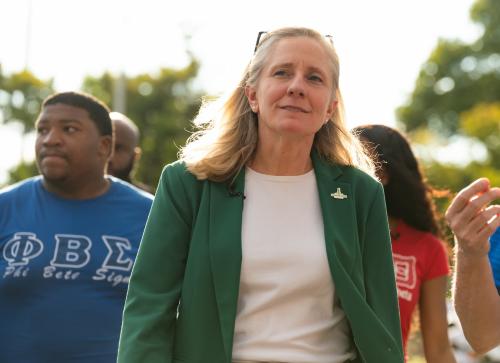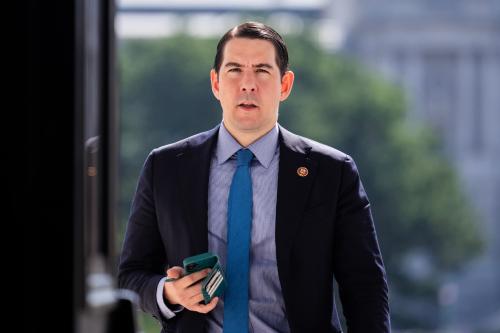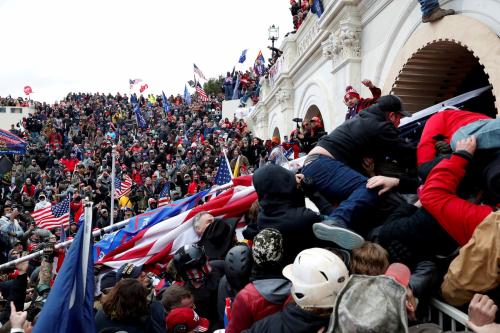On Sept. 11, 2025, Senate Republicans invoked the nuclear option to change chamber rules to allow for the bundled consideration of nearly all executive nominees with a simple majority vote. This represents a dramatic change in the Senate confirmation process, allowing much quicker consideration of nominees once the committees report them to the Senate.
Since President Trump was inaugurated, Senate Democrats have demanded time-consuming roll call votes to cut off debate and confirm nearly every nominee. Because Senate rules traditionally required the chamber to consider each nominee individually, the pace was extraordinarily slow—prompting even President Trump to publicly vent his frustration.
With roughly 1,340 presidential appointees requiring Senate confirmation, recent presidents have had high-level vacancies well into their four-year term. The rule change last month now allows the Senate to confirm executive branch nominees in batches, speeding up confirmations considerably. On Sept. 18, Senate Republicans confirmed the first bundle of 48 nominees. The next bundle is over twice as large with 108 nominees, including 29 ambassadors, 16 U.S. attorneys, seven undersecretaries, six general counsels, and an inspector general.
To evaluate the potential impact of this new rule, we take a closer look at the confirmation process itself—its mechanics and historical patterns. Our analysis shows that while en bloc voting is unlikely to dramatically speed up the overall process, it could make a noticeable difference at the final stage: the floor vote.
Background: Steps in the nomination process
The Senate confirmation process begins by referring nominees to at least one committee with jurisdiction over the position. While committees vary slightly in their procedures, generally, committees review materials provided by the Presidential Personnel Office (PPO). Even though PPO typically provides biographical information and a report or summary of background checks and financial disclosure forms, the committee conducts its own research on the nominee in addition to asking the nominee to fill out a unique questionnaire (topics include bibliography, past writings and statements, policy views, and finances).
Once the nominee’s paperwork is complete, the committee typically requires her or him to undergo an interview with committee staff and attend a formal hearing. High-profile nominees tend to have individual hearings, while lower-level nominees may be invited to a joint or panel hearing with several other nominees. After hearings, nominees are required to provide written responses to additional “questions for the record” that are submitted by individual senators on the committee.
Finally, Senate committees hold a vote on whether to report a nominee out of committee. If reported out favorably, nominations go to the executive calendar, where they await final consideration.
As this description highlights, the most thorough vetting of nominees takes place in committee, where senators have the greatest ability to review nominee backgrounds, qualifications, and conflicts of interest. Senators also have the greatest access to nominees to ask pertinent questions through staff interviews, hearings, and questions for the record.
The committee process also tends to be where most nominations will fail if they do not reach confirmation. For example, in the Biden administration, while 89% of nominees were ultimately confirmed, the success rate improved to 97% if they were reported out of committee and reached the Senate executive calendar.
The recent “en bloc” change to the Senate rules does nothing to alter the committee process and its vetting of nominees. Unless committees change their approach to vetting nominees, the rules change will only impact the very last step of the process—the confirmation vote on the Senate floor.
Committees and the confirmation process in the second Trump administration
During the second Trump administration, committees appear to be largely following standard patterns for their review of the president’s nominees. The average time that Trump’s confirmed nominees have spent in committee before reaching the floor is slightly longer (56.1 days) than Biden’s nominees (51.4 days) through Sept. 16 of the first year. Notably, however, committees are taking 54% longer to review Trump’s nominees compared to his first term, but that was likely due to nominees in the second term not completing their ethics and background checks promptly, delaying the Senate committees’ ability to complete their vetting process.
Committees are also holding hearings for nominees at a rate similar to previous administrations. Through Sept. 16, 99.2% of Trump’s confirmed nominees had a hearing before at least one committee. This is marginally higher than his first term (96.6%) or Biden’s (98.5%) at the same point in time.
Together, these indicators suggest that the Senate is not changing its approach to reviewing and vetting presidential nominees. However, it is possible, particularly for the party of the president, that the rule change and ability to confirm nominees more quickly once they reach the floor may encourage committees to expedite their vetting. Additional study and monitoring may well bear this out over time.
Expectations for reducing confirmation delay
At the 200-day mark, Trump’s nominees faced the longest confirmation delays of any president since Reagan. We can expect that the rules change will reduce the amount of time it takes the Senate to consider nominees on the floor. Interestingly, floor delays historically have been a small part of the confirmation process. In the George H.W. Bush administration, the time nominees spent on the executive calendar took up only 8% of their total time in the confirmation process. However, as fewer nominees were confirmed via unanimous consent, the floor process began to consume more time. For Presidents Clinton and W. Bush, time on the floor took up 25% of the confirmation process in their first terms. For Biden, time on the executive calendar expanded to 37% of the process.
So far into the second Trump administration, nominees have spent almost 36 days on the executive calendar before being confirmed, 39% of the time needed to get confirmed. This is nearly double the amount of time nominees spent on the floor in the first Trump administration and 50% longer than under Biden at the same point in time.
Over the course of the four-year term, the floor delays become even longer. By the end of the Biden administration, nominees had spent an average of 70 days on the executive calendar before being confirmed. In previous administrations, Senate staff may have had to negotiate a deal and wait for a package of nominees to be considered under unanimous consent. Now, the majority has the power to move these types of packages on their own.
In terms of saving time for the Senate, the rules change may indeed make a meaningful difference. One way to illustrate just how effective the new rule can be is to calculate the time saved by bundling. Before the rules change, without unanimous consent, nominees needed to be considered individually, requiring a cloture vote, a two-hour post-cloture debate period, and a final vote on each nominee. According to a study by the Bipartisan Policy Center, the Senate spent roughly 40 minutes on an average roll call vote. This adds up to about three and a half hours on the floor for each nominee. After the rules change, an unlimited number of nominees can be bundled together and considered at once. Twice now, Republicans have put forward a resolution that allows for en bloc consideration of the nominees. Without unanimous consent, a cloture vote, 30 hours of post-cloture debate time, and a final vote are needed for the resolution to be agreed upon. Once agreed to, another cloture vote, 30 hours of post-cloture debate time, and a final vote must occur for the bundle of nominees to be confirmed. This adds up to roughly 62.5 hours of floor time for each batch of nominees. Before the rules change, it would have taken 168 hours to confirm 48 nominees individually. The larger the bundle, the more dramatic the time savings. For the bundle containing 108 nominees, it would have taken 378 hours under the old rules instead of 62.5. According to the latest volume of “Vital Statistics on Congress,” the Senate spent an average of 5.5 hours per day in session and 2,042 hours in the entire 117th Congress. That means that the two bundles of confirmed nominees saved 76.5 session days or 20.6% of the total hours spent in session during the 117th Congress—a rather staggering statistic.
Conclusion
Despite presidential public remarks condemning the slowness of the confirmation process and the Republican majority “going nuclear” to clear the way for faster floor votes, the recent rules change was not a panacea. One of the stated goals of the rules changes was to expedite the confirmation process and allow the president to staff his administration. Delays for presidential nominees can still occur at the committee level and are likely to get longer as the four-year term continues.
Bipartisan reform is still possible. We recommend that reform-minded senators begin by simply reducing the number of jobs that require confirmation: that modest change will immediately reduce the workload of committees and senators and likely have minimal adverse impact on government performance. Other industrialized democracies, after all, have very few political appointees. Perhaps they appreciate that the near-constant hiring, firing, rehiring, and vacancies at the most senior level of government inhibit performance and potential.
The Brookings Institution is committed to quality, independence, and impact.
We are supported by a diverse array of funders. In line with our values and policies, each Brookings publication represents the sole views of its author(s).









Commentary
Will the new Senate rule make it easier for presidents to confirm their teams?
October 10, 2025